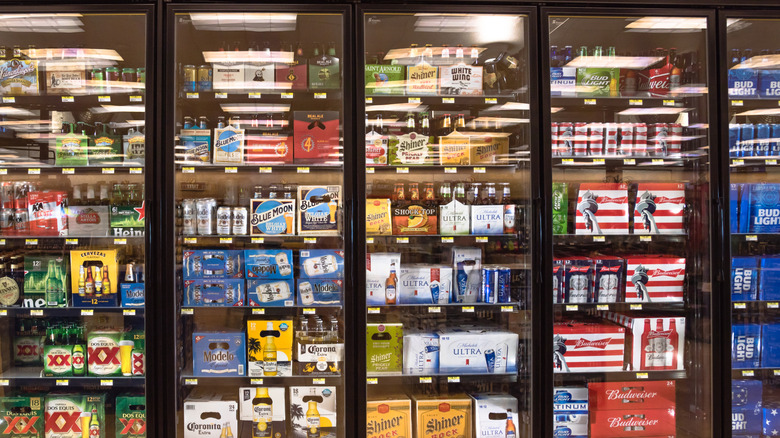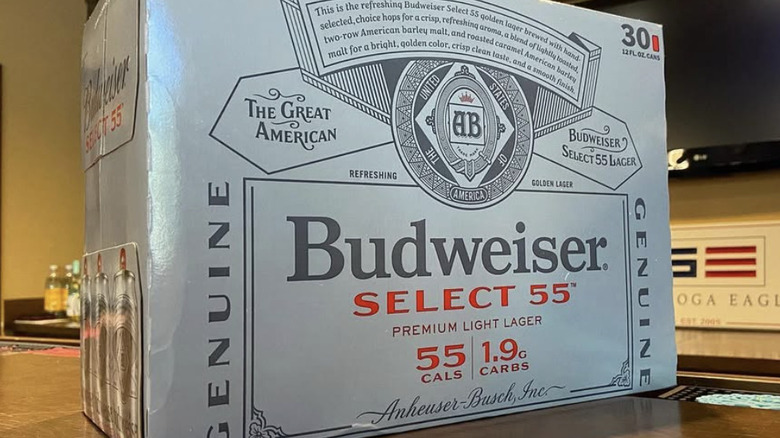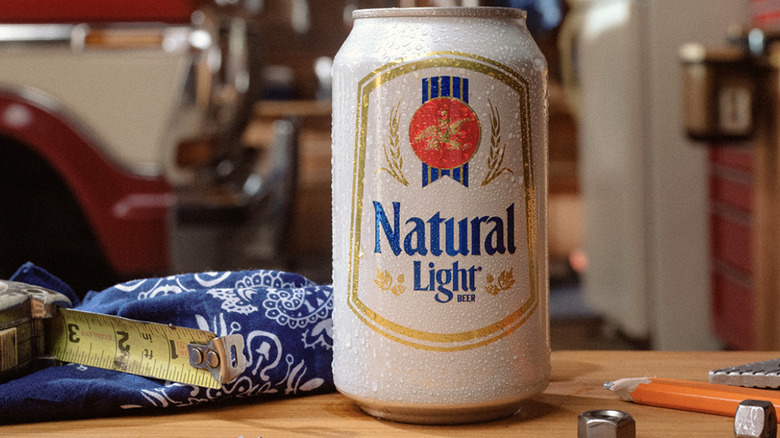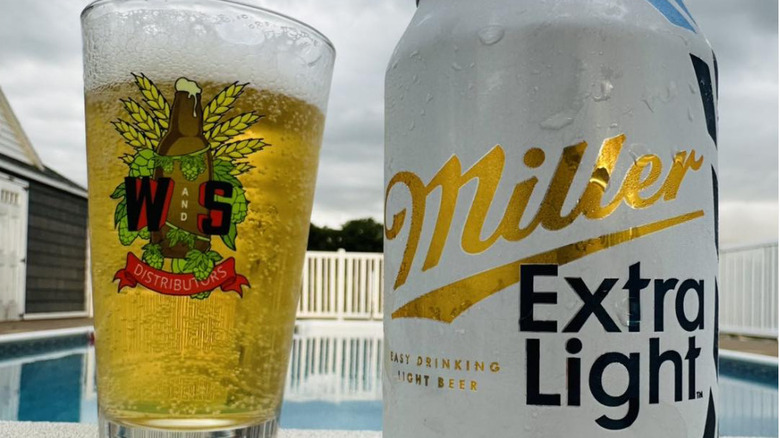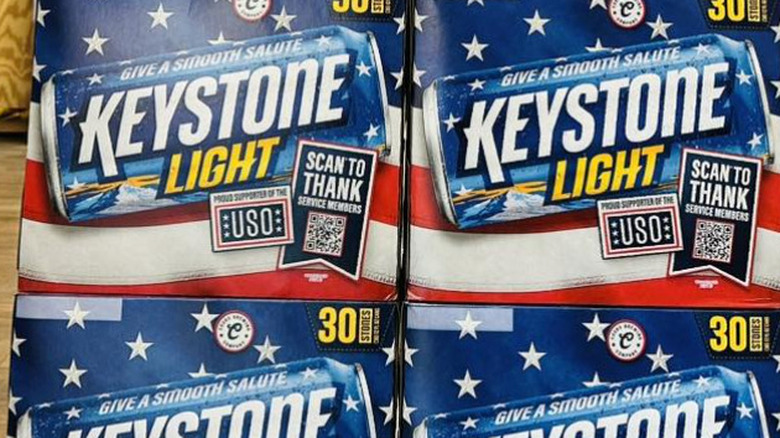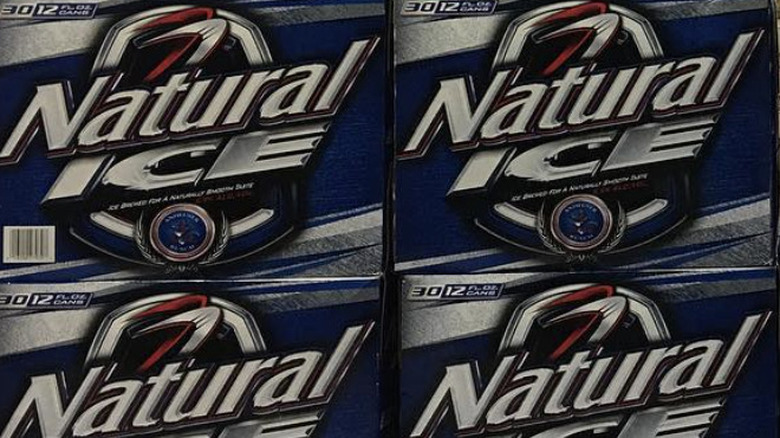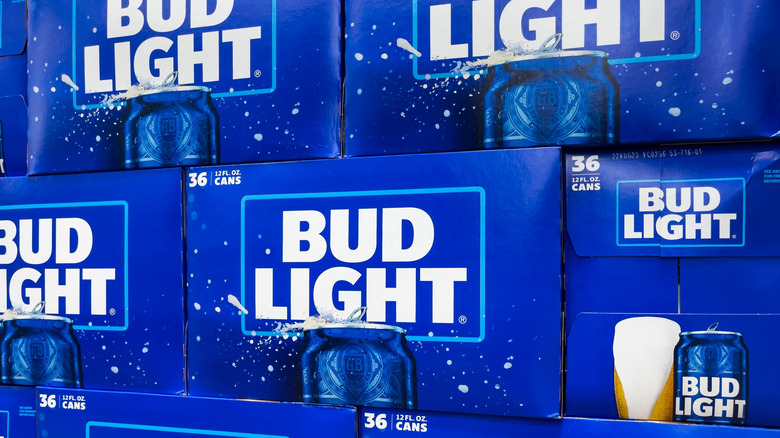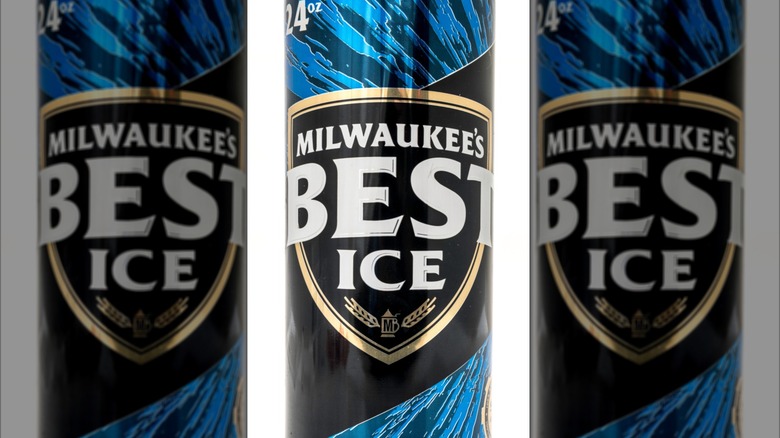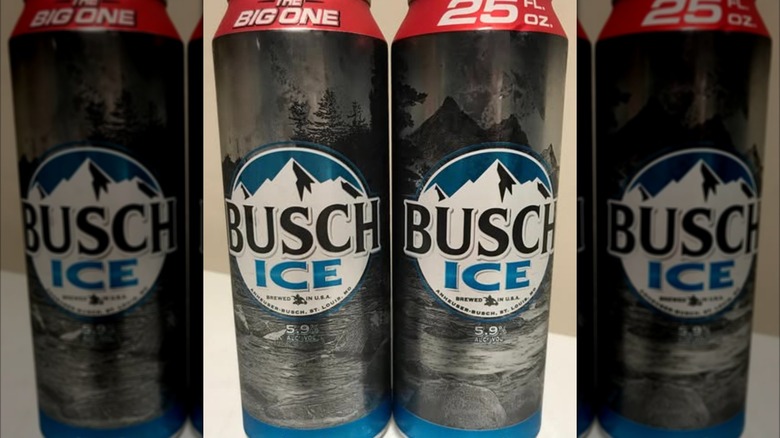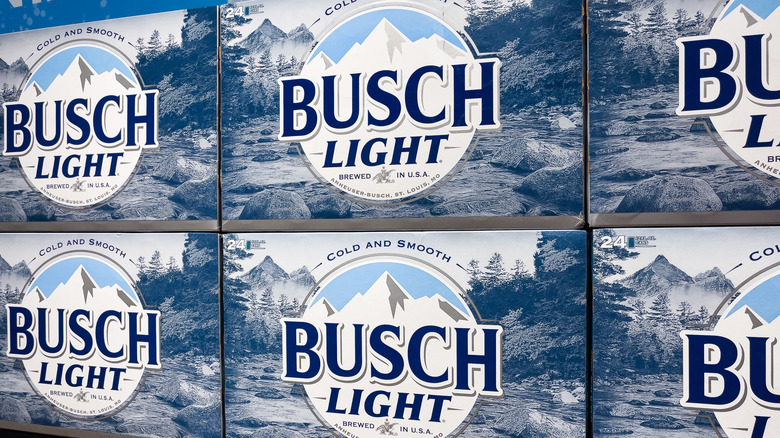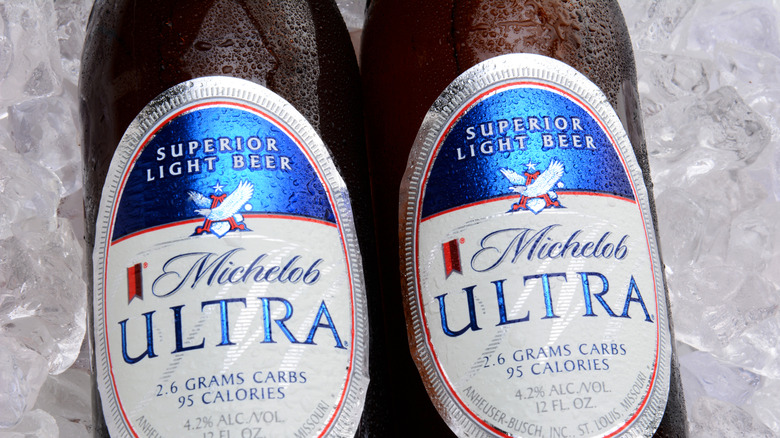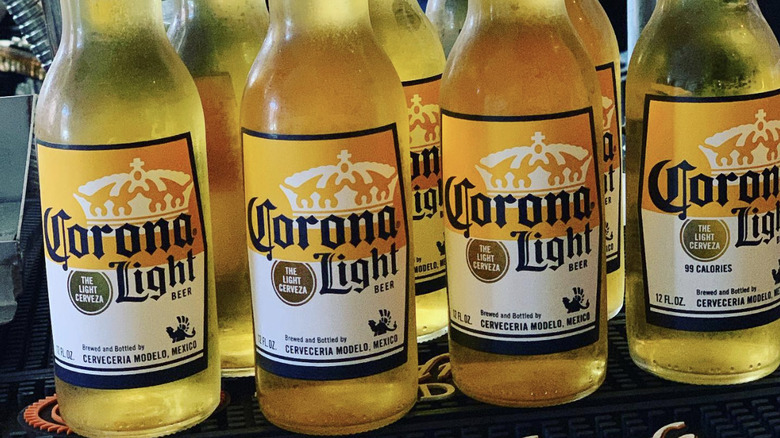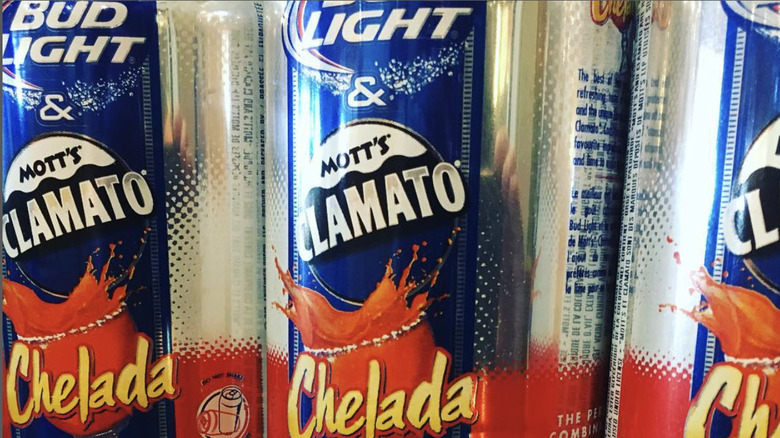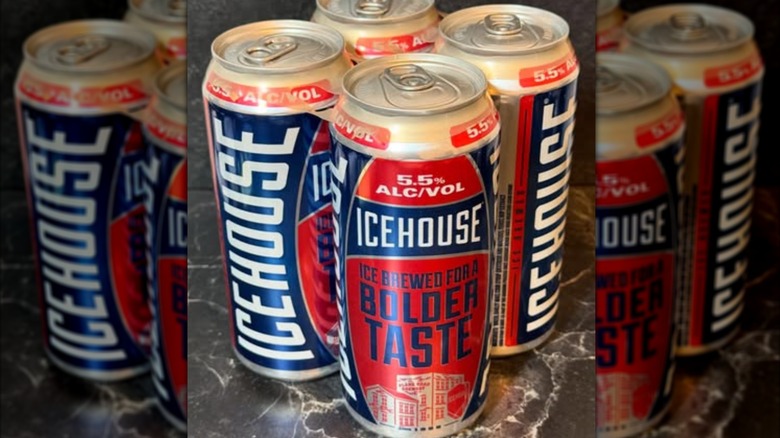Cheap Beer Brands You Should Avoid Buying, According To Customer Reviews
Up until the craft brewing movement made beer into a beverage that was thick, powerfully hoppy, aggressively flavored, very boozy, and demanding analysis, beer was just one thing: lager-style, lightly-flavored, watery, and smooth. Known by a variety of evocative and fitting nicknames like "dad beer," "camp beer," "dirt beer," and "session beer," even the best supermarket beers don't get much, if any, glory or praise from the sophisticated beer-making and beer-enjoying community that dominates the brew scene in 21st century America.
However, those low-key, low-impact, canned, bottled, and on-tap beverages are the top-selling beers in America, as they have been for some time. Macro brews made by gigantic international beer-making concerns use inexpensive ingredients to make simple, thirst-quenching beers enjoyed by the masses. Another big reason for their popularity: they're cheap.
It's in this segment of the beverage world where the adage "you get what you pay for" rings true. Some of the least costly beers widely available are also among the worst-tasting beers in production. Here are some of the least expensive beers, which can be found for a relative pittance in six-packs or giant cardboard suitcases, that just aren't worth the price, according to beer-knowledgeable customers.
Budweiser Select 55
The flagship Budweiser beer begat Bud Light, which in turn led to the release of Budweiser Select 55. It's an ultra-light beer in that it's been seriously reduced in calories and carbohydrates, with just 55 and 1.9 grams of each, respectively. Budweiser describes the beer, sold in packs of 12-ounce bottles and cans, as a golden lager brewed with caramel melts and a variety of hops sourced from around the world.
"This really is the worst beer ever made," WarsawFrost savaged on BeerAdvocate. "Fill a glass with crushed ice and shredded cardboard. Then add a Budweiser to it. Let it sit out on the counter overnight and that would be close to what this tastes like," explained gingeryetiroadbeers. BeerAdvocate critic BBThunderbolt offered more pointed barbs: "I honestly try to find something positive about every beer I try, but even I couldn't find one nice thing to say about this puppy. Clear, urine color. No grain or hop scents. Almost zero flavor. The same amount of body as a glass of water. Water has a higher level of drinkability because it's not pretending it's not water."
That all gives Budweiser Select 55 something of an existential crisis. "If it has no taste, is it really bad?" asked Nick Basham on Untappd. "This one is pretty much flavorless. What do you expect from a lo-cal, lo-carb beer?" offered Chad on Untappd.
Natural Light
Natural Light, so commonly referred to as "Natty" that the company has embraced the nickname in its marketing materials, is a domestic lager, a light beer made in the American style. It's purportedly brewed with a longer process that makes for a beverage that's light on body, color, and calories.
Natural Light obviously has its fans and die-hard consumers, but those who review beer online don't have a lot of nice things to say about the unassuming lager. "Bread-malt nose and taste. After that, nothing," said Karl Meyer on Untappd. "It is watery and without character." On BeerAdvocate, thebadone24 said, "It honestly doesn't get much lower than this. You may as well drink alcohol-laced water if you're going to grab for a Natural Light. The flavor and smell are off-putting." User LeBron_James agreed: "Kind of corny I guess and somehow a little sour," adding, "This tastes like if you left watered down corn tea out in the sun for a week in a plastic cup.
Miller Extra Light
Arguably the lightest beer on the mass market that can still technically be called a beer, Miller Extra Light (recently renamed from Miller 64 Extra Light) is a stripped down version of the already slight Miller Lite. Billed as an "easy drinking light beer," a 12 ounce can of the pale, lager-type brew contains just 64 calories and is also barely alcoholic, with a 2.8% ABV level.
"More like a soda than a beer. One of the worst travesties to have passed my lips," KACK1533 said on BeerAdvocate. "Perfect for having after a marathon lawn mowing run. Wouldn't consume otherwise." Other reviewers agree: "One could think about drinking a beer and it would be more like drinking a beer than drinking this beer. When the calories were cut, so were the taste and ABV. This is the opposite of a too high and intrusive ABV beer," wrote hank_and_als_beer_reviews. "Tastes like someone dumped pool water in a Miller Lite," wrote Untappd user Dylan Wicks. Sean Mealins, meanwhile, compared it to a "beer flavored LaCroix. Terrible."
Keystone Light
Most other nationally distributed light beers have tried to establish themselves with cold, hard numbers: That they ought to be consumed because they don't have high counts of carbs, calories, or alcohol. Keystone Light is different in that it has always emphatically promised a great tasting beer. Upon its debut in 1989, it was marketed with the catchphrase "Bottled Beer Taste in a Can." A decade later, the slogan changed to "Smooth, Never Bitter Taste."
"When you need a beer real bad, it's a real bad beer," quipped AlfaTX1 on Reddit. "It is gross, but still drinkable. It tastes and smells 'swampy,'" said zaxnation. "Bitter cheap beer taste. I can't really quantify it. Is it corn? Some other type of grain? Is it even fermentable?" asked DrewV on BeerAdvocate. "Just a terrible, watery, virtually nonexistent flavor." The diluted taste is a common complaint: "This beer pours a terrible yellowish color. It has the appearance of watered-down beer. The taste is so light and unappealing that I could not finish more than two sips," advised ronniebruner on BeerAdvocate. "I would recommend avoiding."
Natural Ice
"Ice" beers hit American stores and bars in the early 1990s, and while it seemed like a fad, the style developed a fan base. It brews at a temperature that causes liquid to freeze, and ice crystals to develop in the beer. That, in turn, leads to a slightly more intense version of the gently flavored lager and allows for higher alcohol content. Anheuser-Busch's Natural Ice, one of the longest-lasting ice beers, boasts a robust ABV of 5.9%, for example.
"Yes the ABV is a bit higher than the average light, American macro brews but there comes a point in which the flavor has to be discussed. My first pour smelled like farts and tasted like dirty metal water," opined Camu2003 on BeerAdvocate. "The head was as impactive as a Diet Coke. Beer should be judged on its objective, but my question is, what's trying to be done here?" Natural Ice has earned a lot of vitriol among Untappd users. "Swill. Revolting. Barf in a can," said Adam Newman, while Charles Genton proclaimed it "Worst beer ever." "It has neither character, nor flavor," Karl Meyer noted, and Lim added, "Truly I don't know why anyone would buy this."
Bud Light
One of the top-selling light beers in the United States, and one of the overall most popular beers around the world, Bud Light hit stores in 1982 and quickly entrenched itself as an easy to drink beverage with a mass appeal and a then-novel premise: It had far less calories than standard Budweiser, but retained almost all of the flavor. Also, Bud Light was the first American beer labeled with nutrition facts.
"Dead awful water beer, drab bodied and forgettable," Maxxumus said on BeerAdvocate. "Taste is at first very sweet grain which gives way to a weird carbonated bitterness and the signature macro soapiness. Weirdest macro light I think I've had," concluded hankboris. "Can't believe people drink this stuff. With all the real beer available, this watered-down swill still has a following. Do yourself a favor folks and try something else," Joe Spivey wrote on Total Wine. "Bud Light is the worst beer on the planet," GMoney23 rated, while JS789 said that it "has a revolting sickly sweetness from the rice while also being flavorless. Also at 110 calories, this isn't even that light."
Milwaukee's Best Ice
A hearty Midwestern brand since it was first commercially brewed in 1895, Milwaukee's Best is now under the purview of the Molson Coors international brewing conglomerate. It currently offers two flagship brands that attract consistently large customer bases for their affordability and moderate alcohol content. Along with Milwaukee's Best Light, the brewery churns out Milwaukee's Best Ice, an American lager with a glossy texture and retreating taste that hides its 5.9% ABV, a big number for what's also a light beer.
Very few available-everywhere in large racks and at rock-bottom prices can also claim to be award-winners, but Milwaukee's Best Ice is technically acclaimed: It won bronze medals at both the 2003 Great American Beer Festival and the 2006 World Beer Cup. Plenty of everyday beer drinkers don't agree with those competitions' judges. BeerAdvocate reviewer FreePal88 decried Milwaukee's Best Ice's "naturally skunky flavors that are there no matter how fresh it is," adding that the beer "tastes cheap and unclean." The brew is "absolutely garbage" according to Untappd rater ethan-is-stinky, while John Mack disapproved of the beer's powerfully starchy taste, likening it to "carbonated Cheerios."
Busch Ice
Yet another beer made with freezing and crystallization of which a lot can be purchased for not a lot of money is Busch Ice. Rolled out in 1995, the value brand brew is a result of a scientific, temperature-manipulating process that results in a sweet-tasting and silky textured product with a 5.9% ABV, quite high for this beer segment.
"The feel is light and watery, but still implies a heaviness through a sickness, and what I can only describe as heavy vapors being left on the palate. At least you can drink it fast. Overall, don't buy this unless it's incredibly cheap," said JZH1000 on BeerAdvocate. "Unfortunately, it smells like floral vomit," added MikeWard. "I guess people like that skunk at the end?" Untappd user Bethany R asked rhetorically. The beverage was "Weirdly sweet" and "not the best ice beer that's for dang sure," according to Simeon Vizzle, while Richard Willsea was more succinct: "This is really horrific."
Busch Light
As it's subjected to a longer brewing process, Busch Light ends up a watery beer that's devoid of almost everything except a very slight but definitive beer flavor. A can of the St. Louis area classic contains just 3.2 carbohydrates and 95 calories, and with an ABV of 4.1%, it's an ideal light beer.
"It's almost as translucent as club soda, or soda water, depending on where you live. There is a faint smell of adjunct lager to be found, but it's characterless," JohnniEMc criticized on BeerAdvocate. "There may be few other beers like this, in that there's virtually no taste to describe." "Very watery, not much flavor," wrote Steve Jennings on Untappd, where Jared McCrackin said, "Not great, not terrible either." "Perhaps one of the most undrinkable beers ever made," J N MN reviewed on Total Wine. "For the love of all that is hoppy what the heck do people see in this beer? It doesn't really have a taste, and as with any weak-kneed beer it can only be choked down if it's served at 33°F."
Michelob Ultra
In 1896, Anheuser-Busch created Michelob as a premium line, making it available only in fancy hotels, restaurants, and theaters. Sold in glass bottles throughout the late 20th century and beyond, Michelob retained its reputation as a slightly elevated version of the standard American beer. In 2002, the brewer finally made a big play toward the masses with Michelob Ultra, a "Superior Light Beer." Marketed as a beer so lightweight that it can be enjoyed as an accompaniment to sports and physical activity, Michelob Ultra became America's third-biggest beer brand thanks in part to how one bottle houses only 2.6 grams of carbohydrates and 95 calories to go along with its 4.2% ABV.
"Tapwater has more flavor than Michelob Ultra," BeerAdvocate user Jacko52 alleged. "Not beer. It's maybe 10% of the way to being beer," agreed Some_Beer_Sometimes. "It's mostly water, but there is a teeny tiny bit of citrus and bitterness. But there's also metal, slight p***, and mild burnt hair. There's literally no foam." "Ultra has got to be one of the least beer tasting beers," Reddit user mikeymigg reviewed. "Like an artificial beer flavored seltzer."
Corona Light
Corona, the beloved warm weather and beachside beer, is technically known as Corona Extra, to differentiate it from its less-respected and less-enjoyed sibling brew, Corona Light. A bottle of the stuff looks like a Corona, but it doesn't hit the body the same way. Its low ABC of 4% carries with it just 99 calories and 4.8 carbs per serving, making the pilsner-style lager one of the lightest light beers around. A Corona Light also doesn't taste as good as a Corona Extra, according to beer experts — and it's not even close.
"Yeah, it's cheap but so are many other beers that top Corona. Ingredients taste basically like stale soda water and light beer flavor," wrote Mikehicks100 on BeerAdvocate. "Not much is going on in the taste. Well, this is the way it was intended to be," lamented Sinfull. On Untappd, Eric C compared Corona Light to "licking moldy styrofoam." Untappd user Scott A said, "If you squeeze a lime in this beer it has taste, otherwise what is in the can is tasteless." Other Corona Light samplers have found that the beer can turn quickly, and impart a bitter taste. "Skunking from UV," q-ka said on Reddit, referring to how light can shine into the clear bottles and ruin the product.
Bud Light and Clamato Chelada
You can make cheap beer taste better with a pinch of salt and lime juice, which is called a Chelada. Or, you can add tomato juice and other ingredients to create a michelada. Budweiser also produces some canned versions of the Mexican and Latin American beer cocktail, such as the Bud Light and Clamato Chelada. Definitely different from the other beers on this and most any other list, it's a mixture of that ubiquitous low-calorie lager and Clamato, a cult favorite and somewhat off-putting bottled beverage that marries tomato juice, sugar, and clam broth.
"All I could taste was the Clamato, it tasted like drinking a bottle of tomato sauce with fish marinating in it," NiamhCahill wrote on BeerAdvocate. "The balance between beer and Clamato was entirely nonexistent, was extremely extremely upset with this drink. I don't know if I will ever be able to drink a Bud Light again." "This is just non-potable," added chum_husk. "Spoiled Clamato and rotgut vodka are the dominating flavors." "This is gross," Brian Z wrote on Untappd. "I'm pretty sure this was nearly the worst beer I've ever had. Except for the regular Bud Chelada I had next," Josh Learn added. "Nasty."
Icehouse
The very first American-made ice beer available for public consumption was Miller's Icehouse. Since 1993, it's offered a compromise for beer drinkers looking for an inexpensive brew that also had a higher alcohol content than its competition in the industrially-produced lager field, with an ABV of 5.5%.
Icehouse's main selling point is its price. It's one of the absolute cheapest nationally distributed beers in production, with even an extra-large "tallboy" can selling for around $1 or so. Discerning beer drinkers don't think that's necessarily a positive. Untappd user Carter Petrilla likened an Icehouse to "a Pabst Blue Ribbon made by Dollar Tree," adding that the beer was "not terrible, but it would be worth the extra $1.25 to upgrade." "This beer is just terrible. First off I got it skunked and the fact that it is so cheap should set off some lights," warned spiffysamurai on BeerAdvocate. "It tastes metallic and like poison. You're better off sober," AndrewFord666 advised on BeerAdvocate. A user named BeerAdvocator also noticed "a weird grainy malty taste and nothing else."
